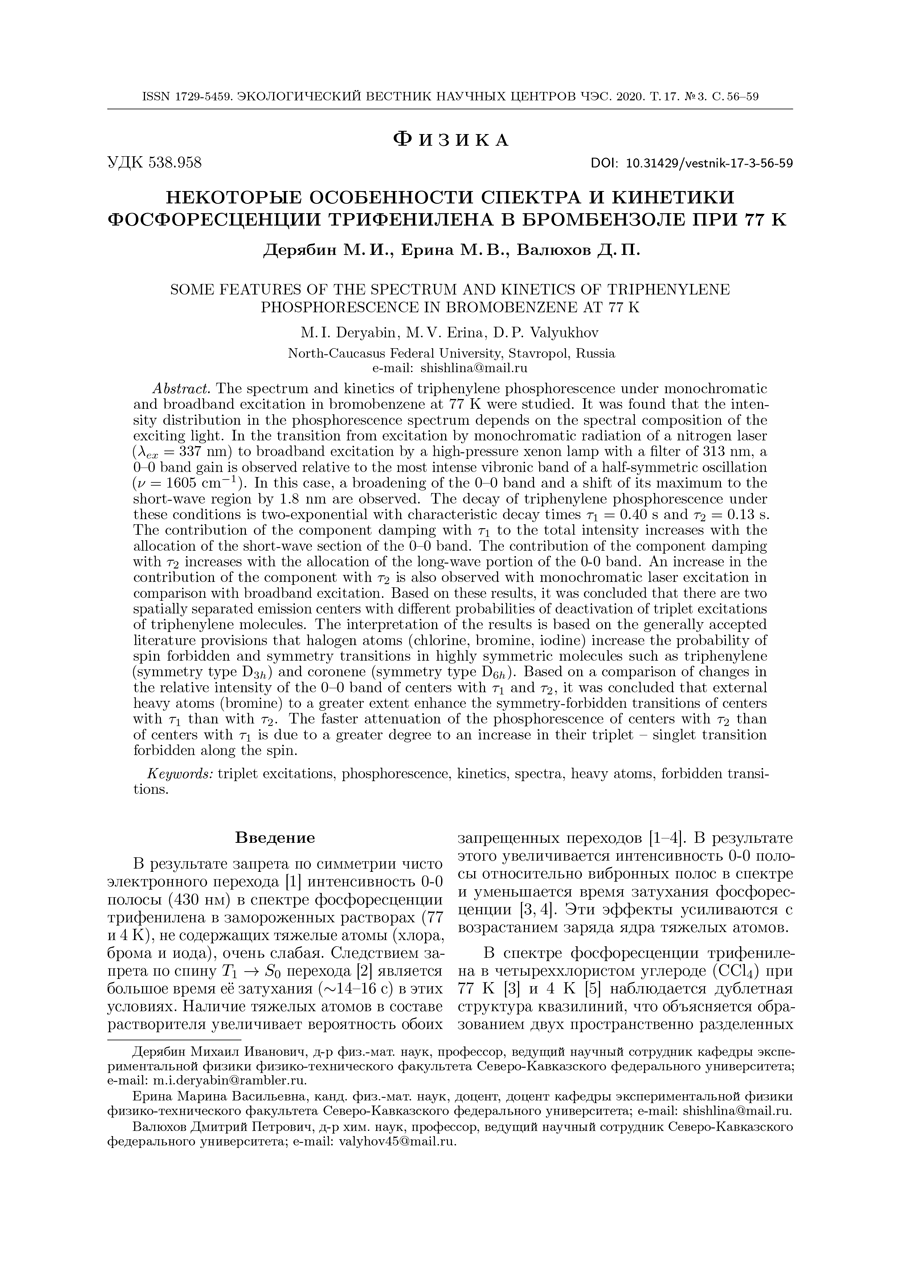Some features of the spectrum and kinetics of triphenylene phosphorescence in bromobenzene at 77 K
UDC
538.958DOI:
https://doi.org/10.31429/vestnik-17-3-56-59Abstract
The spectrum and kinetics of triphenylene phosphorescence under monochromatic and broadband excitation in bromobenzene at 77 K were studied. It was found that the intensity distribution in the phosphorescence spectrum depends on the spectral composition of the exciting light. In the transition from excitation by monochromatic radiation of a nitrogen laser ($\lambda_{ex} = 337$ nm) to broadband excitation by a high-pressure xenon lamp with a filter of 313 nm, a 0--0 band gain is observed relative to the most intense vibronic band of a half-symmetric oscillation ($\nu =1605$ cm$^{-1})$. In this case, a broadening of the 0--0 band and a shift of its maximum to the short-wave region by 1.8 nm are observed. The decay of triphenylene phosphorescence under these conditions is two-exponential with characteristic decay times $\tau_{1} = 0.40$ s and $\tau_{2} = 0.13$ s. The contribution of the component damping with $\tau_{1}$ to the total intensity increases with the allocation of the short-wave section of the 0--0 band. The contribution of the component damping with $\tau_{2}$ increases with the allocation of the long-wave portion of the 0-0 band. An increase in the contribution of the component with $\tau_{2}$ is also observed with monochromatic laser excitation in comparison with broadband excitation. Based on these results, it was concluded that there are two spatially separated emission centers with different probabilities of deactivation of triplet excitations of triphenylene molecules. The interpretation of the results is based on the generally accepted literature provisions that halogen atoms (chlorine, bromine, iodine) increase the probability of spin forbidden and symmetry transitions in highly symmetric molecules such as triphenylene (symmetry type D$_{3h})$ and coronene (symmetry type D$_{6h})$. Based on a comparison of changes in the relative intensity of the 0-0 band of centers with $\tau_{1}$ and $\tau_{2}$, it was concluded that external heavy atoms (bromine) to a greater extent enhance the symmetry-forbidden transitions of centers with $\tau_{1}$ than with $\tau_{2}$. The faster attenuation of the phosphorescence of centers with $\tau_{2}$ than of centers with $\tau_{1}$ is due to a greater degree to an increase in their triplet - singlet transition forbidden along the spin.
Keywords:
triplet excitations, phosphorescence, kinetics, spectra, heavy atoms, forbidden transitionsReferences
- Zander, M. Note on the Influence of External Heavy-atom perturbers on the phosphorescence spectrum of triphenylene. Z. Naturforsch, 1984, vol. 39a, pp. 1145–1146.
- McGlynn, S.P., Azumi, T., Kinoshita, M. Molecular spectroscopy of the triplet state. Prentice-Hall, 1969.
- Butlar, V.A., Grebenshchikov, D.M. Spektry fosforescencii koronena i trifenilena v chetyrekhkhloristom uglerode [Phosphorescence spectra of coronene and triphenylene in carbon tetrachloride]. Optika i spektroskopiya [Optics and Spectroscopy], 1967, vol. 22, no. 5, pp. 758–762. (In Russian)
- Korotaeva, E.A., Naumova, T.M. Intramolecular interactions forming the phosphorescence spectrum of triphenylene. J. of Applied Spectroscopy, 1985, vol. 42, pp. 650–655.
- Giachino, G.G., Kearns, D.R. External heavy atom perturbation of vibronic transitions in singlet–triplet spectra. J. Chem. Phys., 1970, Vol. 53, iss. 10, pp. 3886–3891.
- Lamotte, M., Merle, A-M., Joussot-Dubien, J., Dupuy, F. Multiplet structure of the emission bands of coronene and perylene in n-heptane single crystals. Chem. Phys. Letters, 1975, vol. 35, no. 3, pp. 410–416.
Downloads
Submitted
Published
How to Cite
Copyright (c) 2020 Deryabin M.I., Erina M.V., Valyukhov D.P.

This work is licensed under a Creative Commons Attribution 4.0 International License.




